Special Feature: 500th Anniversary of the Protestant Reformation
Following the Footsteps of
the Protestant Reformation
On October 31, 1517, Martin Luther nailed the Ninety-five Theses on the door of the Wittenberg Church, triggering the Protestant Reformation. This year marks the 500th anniversary of the Reformation. Internally, it is the 10th anniversary of the publication of the History of Redemption series of Huisun Rev. Abraham Park, the founder of Pyungkang Cheil Presbyterian Church. This special year also marks the 60th anniversary of his ministry. The church organized a team to deeply explore through the history of the Reformation. This team traveled to Europe and visited several sites including Germany, Switzerland and Scotland for thirteen days, from August 21st to September 2nd. The purpose of this trip was to learn from the reformers such as Luther, John Calvin and John Knox, who are the root of today’s Protestant churches. In particular, through this special series, we wanted to share with the readers and review the reformative faith of Rev. Abraham Park through texts and photos. This will be a special four-part series. - Editor’s note
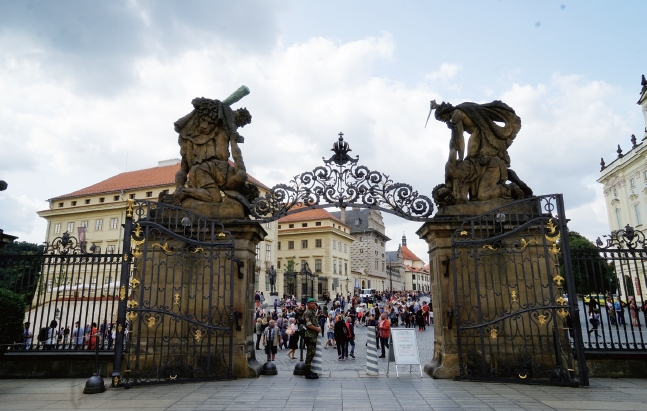
Prague, Where the Morning Star of the Reformation First Appeared
The team first visited Prague Castle in Prague, which is the capital of the Czech Republic. The construction of Prague Castle began in the middle of the 9th century. It was only during the reign of Charles IV in the 14th century that the size of the castle came close to its current size of 570m in height and 128m in width. It has been used as a presidential palace since 1918, and is also listed as the world’s largest castle in the Guinness Book of World Records. The splendour of the St. Vitus Cathedral welcomes each person that first steps foot inside the castle. The construction of the cathedral took about 600 years, beginning in 1344 and being completed in 1929. To the right of the altar is a room that was once the chapel of King V?clavis. His crown and jewels are still kept there and the room is decorated with over a thousand jewels. Underground lays his tomb along with other royal tombs.
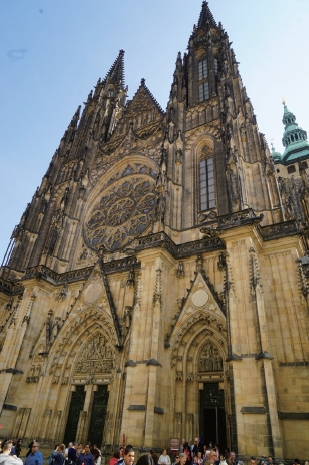
The Prague Castle is linked to John Knox four years after his death. July 30, 1419, is known for the Prager Fenstersturtz incident, which is the day the followers of Jan Hus, archbishop of Czechoslovakia, killed seven members of the local council by throwing them out of the window after his death on the stake. The second incident happened about 200 years later on May 23, 1618.
When Ferdinand who took the throne of Bohemia, what is Czech today, declared himself to be a Catholic and oppressed Protestantism as soon as he rose to power, the enraged royals and people of Bohemia threw three rulers out of the window in place of Ferdinand. This incident instigated the Thirty Years’ War between the Catholics and Protestants. The European continent went through a fierce war that lasted thirty years before the peace treaty was established in Westfalen in 1648.
The most important article out of the four articles in the treaty is the first article that acknowledges the freedom of religion for the Calvinists within the Holy Roman Empire alongside Catholicism and the Lutheran church, giving people the freedom to choose their religion. The blood of the martyrs of reformation had bore fruit at last and granted the freedom of religion for individuals and brought about the acknowledgment of Protestantism. The window of the Prague Castle that silently lets in the sunlight are is an important starting point that marked a new era in the history of the religious reformation.

Jan Hus (1372-1415)
Hus studied theology at the University of Prague in the Czech Republic and later served as rector of the university. He was fascinated by the writings of John Wycliffe in his youth and deeply held in his heart Wycliffe's claim that the church is a “congregation of the predestined” of which Christ, not the pope, is the head. Hus took up the reformed theology teachings of Wycliffe (1320-1384) who had taught theology and philosophy at the University of Oxford in the mid-14th century.
Wycliffe insisted that true authority comes not from the pope, but the Holy scriptures, making priests and laymen are equal before God. Wycliffe emphasized the corruption of Roman Catholicism and taught that preaching was more important than administering the sacraments. He also said that each person had the right to study the Bible. To make this happen, Wycliffe began collecting Oxford scholars to begin translating the Vulgate (Latin Bible) into Middle English. Together, they created the first English Bible, the Wycliffe Bible. In 1382, the Blackfriars Synod condemned Wycliffe’s writings, and later on his followers, the Lollards, were persecuted.
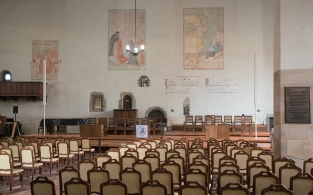
Hus learned of Wycliffe’s ideology during his years of study in Oxford, Prague. As he preached of his reformative ideology in the Bethlehem Chapel later on, he denounced the belief that a special grace is transferred to those who touch the artifacts of the martyred, and he criticized the Vatican for their sale of indulgences and proclaimed that the Bible is the only foundation for spiritual authority. Hus, who was the president of the University of Prague, was enraged when Pope John XXIII decreed to pardon those who took part in the war in order to gather soldiers for the Crusades, claiming that it was a form of simonism. The residents of Prague agreed with Hus and protested, carrying out a burning ceremony of the Pope’s royal letter that gave out indulgences. As a result, the pope proclaimed a sacramental stoppage in Prague and Hus took refuge in southern Bohemia, spreading the reformative ideology by writing books like <Church> and <Simonism>.
Hus was popular among the people of Prague because he preached not in Latin but in their native language, going against the Pope’s orders to only preach in cathedrals and monasteries and stepping closer to the people by proclaiming the word on campuses and classrooms. The Bethlehem Chapel that he preached at over 3,000 times within 10 years is located near the Old Town Square in Prague. Other tourists gathered in crowds to see the figure of 12 disciples pop out of the astronomical clock at twelve o'clock but we visited the Bethlehem Chapel that did not receive the spotlight. It is a church that is small and shabby like a stable compared to the magnificence of Prague Castle and St. Vitus Cathedral. However, Hus’ pulpit, paintings to teach the Bible to his congregation more easily and the music sheets and lyrics of hymns that are there still pass on the fervent faith and passion of Hus’ reformative beliefs to those who visit. It was as if you could hear Hus’ voice proclaiming the Word of God to the people of the nation with blood-vomiting passion as you stood at the pulpit facing the seats of the congregation.
Eventually, the Roman Vatican issued a subpoena for Hus to appear at the Council of Constance. Hus, sensing his execution, sent the following prayer in his letter to a friend.
“Give me a fearless heart, upright faith, steadfast hope and perfect love so I can lay down my life for You with endurance and gladness. Amen.”
On July 6th, 1415, Hus kept his faith to the end and disappeared into the flames at the stake. It is said that the Vatican was so spiteful and struck with dismay with Wycliffe and Hus’ reformative faith that they used Wycliffe’s Bibles to light the fire to burn Hus alive.
Death of the Goose, Appearance of the Swan
On the afternoon of Saturday, August 26th, Hus stopped by Konstanz that was burned. Currently, the stone his name is carved on is the only one keeping the spot in the corner of the narrow street in Germany’s small town. Hus was burned at the stake when he was sentenced to death at Konstanz where the councils has come to order, without even a single portrait to make his name known.
“You are going to burn a goose but in a century you will have a swan which you can neither roast nor boil.”
Hus prophesied about Luther who would come in a hundred years and whose reforms would not be wiped out.
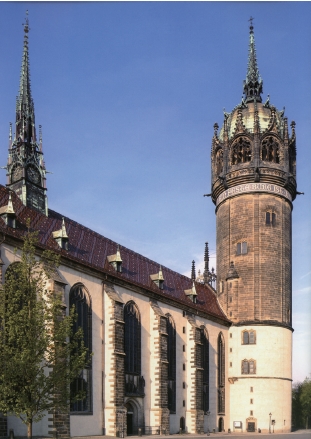
Town of Luther, Wittenberg
After just one day in Prague, the teamwork up early the next morning and departed for Wittenberg, Germany. We arrived at Wittenberg after driving roughly a little over 4 hours on the Autobahn. Wittenberg was full of traces of Luther and lived up to the moniker of Lutherstadt (Town of Luther). Even though he was not physically present, it was as if Luther was still walking within the town and still spreading the Word.
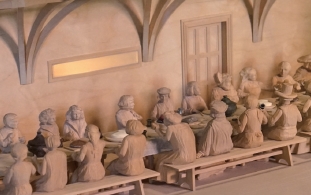
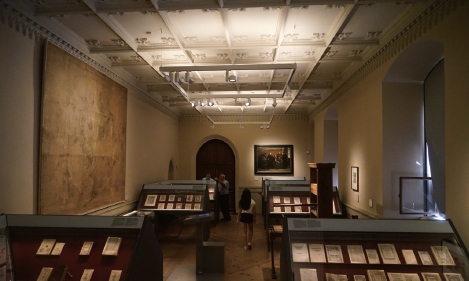
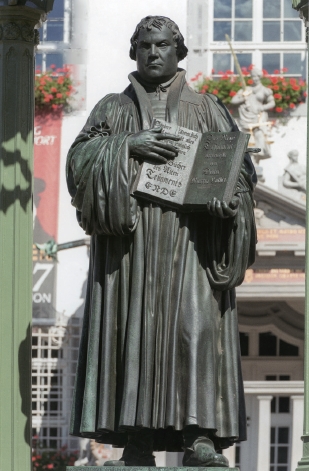
At Wittenberg, there was the Lutherhaus (Luther’s house, where Luther and his family resided and enjoyed “Table Talks” with his disciples, Schlosskirche (Castle church) where Luther’s Ninety-five Theses was posted, Stadtkirche (Town Church), where Luther preached, and Luther’s lifelong collaborator Phillip Melanchthon’s home (Melanchthonhaus). There were also the Wittenberg University, where Luther taught about Romans and Galatians among others, as well as the Town Hall and market square where statues of Luther and Melanchthon greeted tourists. Of all of Wittenberg’s historic sights, Lutherhaus as well as the Schlosskirche, where the Protestant Reforms began, are the most classic. The Lutherhaus building was originally built for the monks of the Order of Saint Augustine and Luther began living there in 1508. On June 1, 1525, Luther married Katharina and lived the rest of his life there, leaving behind many traces. We took a look at the first floor which was used as a conference room and then moved up to the second floor. Luther’s large table and chairs along the walls for his students decorated Lutherstube (Luther’s living room) exactly as it was 500 years ago. Here, Luther shared with Melanchton and other theologians, conversations of reformation. These conversations would later be organized by his disciples into 6 volumes of “Table Talk.” Witnessing the site of inspiration for the second most read book after the Bible in Germany for 400 years, makes me wish I can join in Luther’s teachings and conversations. There were also roughly 40 individual rooms for the monks that were decorated with various books and documents. The memos recorded by Luther from when he translated the New Testament into German and reading the Hebrew Old Testament were all left behind and treasured as is in Wittenberg.
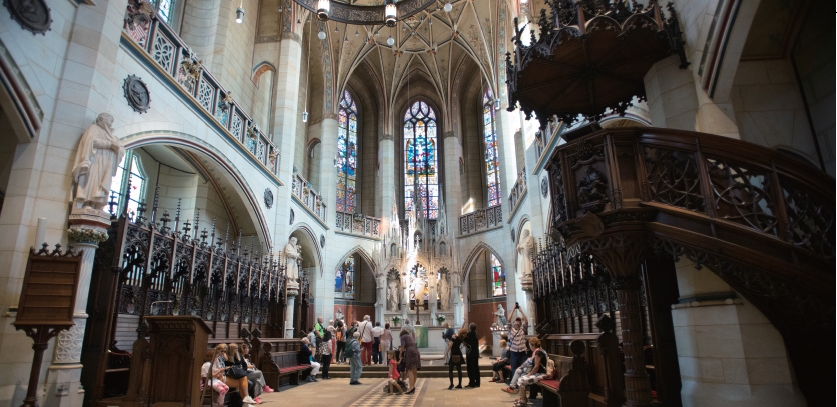
A statue of Luther’s wife, Katharina, greets tourists at the square in front of Lutherhaus. When Luther was 42 in June 13, 1525, he married Katharina who was a nun and 16 years younger and formed the first Protestant clergy family. Luther would express his love for Katharina as, "My Katie is in all things so obliging and pleasing to me that I would not exchange my poverty for the riches of Croesus."
On the road leading to the Catholic Church from the Luther house, there sits the church of St. Marien, the church where Luther did his most of his work, and next to that is the city hall and the town square. Statues of Luther and Meranhiton stand on the left and right sides of the entrance of Wittenberg square to welcome tourists. In particular, the statue of Luther is holding the Bible in his left hand, pointing to the Bible with his right-hand finger while looking out onto the approaching masses. This is a symbol exemplifying Luther's reform of faith, which focused on 'the Bible only' in a society that was at the time full of sacrament and suspicion. Along the middle road heading towards the Catholic church stands the house of Melanhiton and the University of Wittenberg. Although the campus is empty due to students being on vacation, one can only envy that this small university has become the base of the reformation of faith and has contributed to the transformation of human society. The Catholic church is the one sitting on the edge of the city of Wittenberg with the tower and the chapel. In Luther’s time, the front gate of the church was made of wood, which was used for residents to post public notices. But the gate caught fire and was rebuilt in 1858 using iron bars inscribed with 95 articles of script that were destroyed in the fire. A preaching group also presided inside the church, to which Luther preached to, and under which lies the tomb of Luther and his partner, Melanhiton.
On the way to Schlosskirche, there was the Stadkirche (Stadt- und Pfarrkirche St. Marien zu Wittenberg [Town and Parish Church of St. Mary's]), which was where Luther preached and next to it was the Town Hall and the market square. In the market square stand statues of the two heroes of Wittenberg, Luther and Melanchthon. In the statue of Luther, he is holding a Bible in his left hand and with his right hand pointing towards the Bible and is as if he is teaching. Luther taught of a Bible centric faith reform in a society that heavily emphasized holy sacraments and ceremonies. On the way to the Schlosskirche, the Melanchthonhaus and Wittenberg University can be found. Currently, students are away on break, but the fact that this small university was part of the foundation of changing the history of mankind in faith reform is a fact to be envious about. The towering church at the edge of Wittenberg is the Schlosskirche (Castle Church). During Luther’s time, the front door of the church was made of wood, and was also used as an announcement board. The original wooden door was lost in a fire and was replaced in 1858 with an iron door that had the Ninety-five Theses inscribed in it. Within the church is the pulpit and underneath it are the graves of Luther and Melanchthon.
In Catholicism, Cardinal Albrecht created something called “coerced guidance” for merchants of indulgence at the time, but when Luther came across this handbook, he was displeased with its pastoral and theological aspects. The salvation of man was not based on the purchase of indulgences, but on the gospel of repentance. In this spiritual maelstrom, Luther published a refutation of the Ninety-five Thesis, and the first Protestant protest against anti-truths in the spire-like empire parliament in 1529, in which Protestatio arose (Protestantism). Luther stood up as a "crucifix", resisting the religious authorities of the time and the false theology that had been passed down for a thousand years. While Catholics insisted on the "theology of glory", Luther preached about the “theology of the cross,” on which Christ suffered. His bones were buried under the ministry where he preached his entire life and spread the word of his theology.
Crossing the Rubicon of Reformation
When Luther first put up the Ninety-five Thesis on October 31, 1517, the pope did not think much of it, saying, “Luther is a drunken German. He will feel differently once he is sober.” But with the help of the printing press invented by Gutenberg, Luther’s Theses was distributed all throughout Germany and caused a great upheaval within just two weeks. The angry pope denounced Luther, calling him “a wild boar loose in the Lord’s vineyard,” and issued a papal bull ordering him to recant his claims. On October 10, 1520, a copy of the bull was delivered to Luther in Wittenberg and he was obligated to respond within 60 days. And finally on the sixtieth day, December 10th of the same year, Luther gathered the local university students in front of Elster Gate by 9 o’clock in the morning, then set fire to a stack of wood along with documents of scholastic theology and tossed the papal bull into the flames.
As he burned the bull, Luther said, “Because thou hast brought down the truth of God, He also brings thee down unto this fire today.” This was a public confirmation of breaking ties with the Vatican - Luther and the pope had now crossed the Rubicon. As a result, Pope Leo X issued an official letter of excommunication to Luther and his followers on January 3, 1521. With this, a small torch of reformation turned into a wildfire spreading throughout all of Germany and Europe. In 1830, an oak tree was planted on the very spot where Luther burned the Pope’s order in celebration of the 300th anniversary of the Augsburg Confession. Today, this tree is called the “Luther Oak” and stands at the entrance of the city of Wittenberg in the opposite direction from the Castle Church (continued in the next issue).
Translators: In Bok Lee, Euna Kim, David Lim, Enoch Yoo, Sara Kim, Julie Lee
 [Special] Following the Footsteps of the Protestant Reformati...
[Special] Following the Footsteps of the Protestant Reformati...
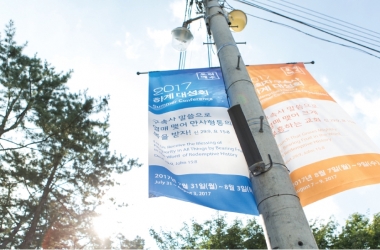 [Interview] The Impossible Dream Comes True : All Nations Com...
[Interview] The Impossible Dream Comes True : All Nations Com...









